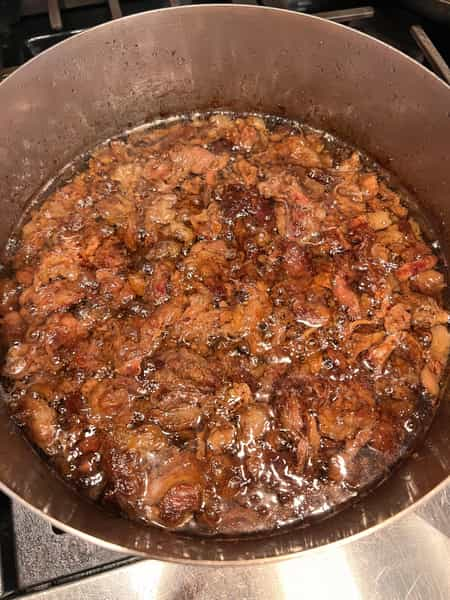In a previous blog, Making Sense of Cooking Fats, I briefly touch on one of my favorite fats for cooking: tallow. Tallow is rendered beef fat from the kidney and other fatty areas of the steer. Rendering is the process of slowly cooking the solidified fatty tissue at a lower temperature to obtain the liquid fat.
For most of human existence, before the introduction of hydrogenated seed oils like Crisco in the early 1900s and even up until the 1960s when “vegetable oils” were deemed the “healthy” option, natural animal fats were the norm for cooking and baking for people all over the world.
In the past decades, they have greatly fallen out of popularity due to much controversy. Primarily tallow and lard were the go-to cooking fats, even McDonald’s used tallow for deep frying their fries until switching to the cheaper option of soy/corn based oil after these agricultural industries were heavily subsidized by government funding.
Without taking you too deep into the rabbit hole of political food narratives (which I’ve ventured through since culinary school in 2010), I will say there is no scientific evidence other than observational study linking animal fats or eggs for that matter to to heart disease or clogged arteries. Besides their higher caloric value, I see saturated fats as the most natural and beneficial types of fat for consumption.
These natural fats are what my Memaw cooks with and what I learned to cook with and have been eating for 35 years. They are great for frying, searing, baking, and making roux. Lard and tallow have a high smoking point and lots of flavor. Some grocery stores may not carry prepared tallow but it does exist, usually in the oil aisle. The other option is making your own, and it’s really quite easy and inexpensive.
When I know I have a need for a large quantity of beef fat, I call ahead to my butcher to see if they have two to four pounds on hand or if they need a few days to save it up as in most cases they just discard it. If you’re close with them, you may even get it for free or at least really cheap. You can also save and freeze your trim fats until you have enough to render. Here is the basic recipe for tallow, and you can use the same process to make lard using pork fat.
Tallow
Scroll down for a printable version of this recipe
Yield: around 3 cups
Prep time: 10 minutes
Inactive time: 3-4 hours
4 pounds trimmed beef fat or suet- diced into small pieces
1. Place the fat in an appropriately sized pot, meaning you should have at least 4 inches of clearance from the fat to the top of the pot to prevent spills.
2. Place the pot on the stove top on a low setting or in the oven at 200-215 degrees. You should see some simmering but no burning or heavy smoking. The point is to cook this low and slow.

4. Before the fat cools, pour everything through a fine mesh strainer lined with cheese cloth. Discard the cooked bits of fat and you’re left with the tallow.
Now that you have your tallow, you’re ready to sear, bake, fry or even make a natural soap or lip balm! Here is a fun recipe using your new cooking fat: confit and fried potatoes.
Confit Potatoes
Scroll down for a printable version of this recipe
Yield: 2 servings
Prep time: 30 minutes
Cook time: 2.5 - 3 hours
Inactive time: 24 hours
1 or 2 russet potatoes
1 cup beef tallow
Salt and pepper
1. Preheat the oven to 250 degrees F.
2. Prepare a small loaf pan by lining it with parchment paper.
3. Peel, rinse, and thinly slice the potatoes on a mandolin.
4. Toss the sliced potatoes in the tallow with salt and pepper.
8. Allow to cool with the weight for at least a few hours, if not overnight, in the fridge.
For more technique-focused dishes like this, check out our five-day Culinary Boot Camp. This deep dive into the fundamental techniques of cooking is comparable to a professional culinary school education for home cooks.
Confit Potatoes
Ingredients
- 1 or 2 russet potatoes
- 1 cup beef tallow
- Salt and pepper
Instructions
- Preheat the oven to 250 degrees F.
- Prepare a small loaf pan by lining it with parchment paper.
- Peel, rinse, and thinly slice the potatoes on a mandolin.
- Toss the sliced potatoes in the tallow with salt and pepper.
- Layer the slices and excess tallow into the prepared baking dish.
- Cover the potatoes with parchment paper and bake them until tender for 2.5 to 3 hours.
- Once tender, place another pan directly on top of the parchment potatoes and weigh them down.
- Allow to cool with the weight for at least a few hours, if not overnight, in the fridge.
- Once chilled and pressed, remove the potatoes from the pan and trim the sides evenly.
- Heat the remaining tallow in a sauce pot to 350 degrees.
- Slice potatoes into 1-inch strips and fry in the tallow until golden brown.
- Drain on paper towel-lined plate.
- Serve with a drizzle of aioli.
